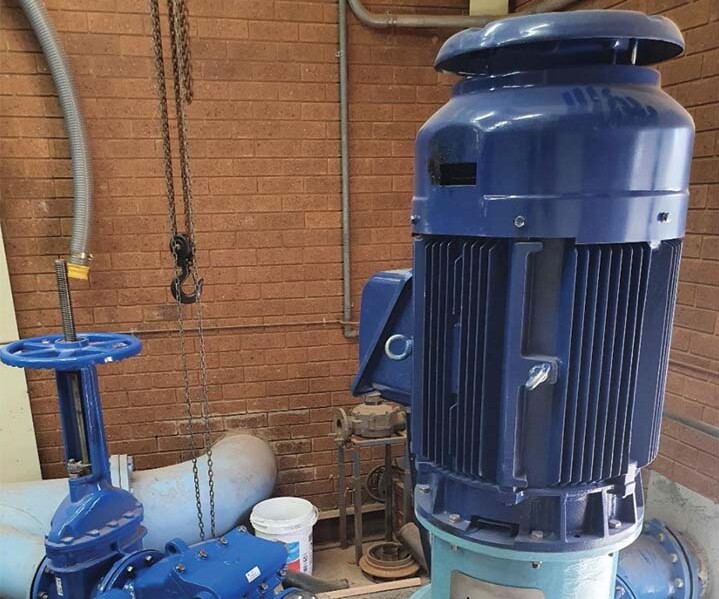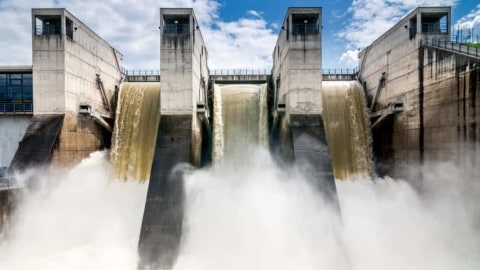By Lauren DeLorenzo, Journalist, Pump Industry magazine
When a water treatment plant is decades older than the local government area that it services, it is bound to experience some aches and pains that result in a lower drinking water quality. This was the case for Forbes Shire Council’s water treatment plant, with equipment reaching the end of useful life or not working as efficiently, and continual breakdowns requiring maintenance. To rectify these issues and ensure the plant can continue to produce high-quality drinking water for decades to come, Council undertook an upgrade to Plant A and Plant B.
The Forbes Water Filtration Plant, which is situated on the Lachlan River, is a conventional filtration plant comprising two trains (Plant A and Plant B) which have their own mixing tank, flocculation and clarifier tanks. Combined, the plants have the ability to deliver 26.5ML per day.
Upgrades of Plant A and Plant B began in 2019 to bring them in line with the highest modern efficiency and monitoring standards required to meet the needs of the community and NSW Health legislation.
Forbes Shire Council Project Officer (Water), Andrew Quirk, said that the upgrades needed to be made for the continued operation of the water treatment plant. “All these upgrades and replacements were needed as our plant had all but reached its useful life age with multiple issues starting to arise – the main issue being the filters not performing consistently,” Mr Quirk said.
“With Plant B first constructed in 1946, and Plant A built in the 1960s, we were experiencing continual breakdowns, which led to us not always meeting drinking water health guidelines.” Other initial issues in Plant A included the failure of a filter. The filter had an old underdrain system, where the pipe had rusted through and filter media was lost through the filter, moving through to the cellar tank.
As the filter had been coated in a black epoxy, there was no visual reference for when it would be back in service. The filter had been out of service for a number of years, as the other nine filters could pick up the extra filtration needs. During the planning of the refurbishment of this filter, another filter presented with the same underdrain issue.
This resulted in the decision to replace all filters in Plant A with new coatings. This decision was to proactively upgrade the filters, rather than waiting for each of the filters to fail, potentially causing catastrophic consequences for the community’s drinking water supply.
What did the upgrades involve?
Bore Water to both plants
Prior to the upgrades, only water from the Lachlan River could be treated in both plants, and bore water could only be treated through Plant B, due to the inlet configuration. The recent upgrades and modifications to the inlet pipework enable bore water to be treated through both plants.
Filter Upgrades
Upgrades to Plant A began in 2019, when one of the filters was rebuilt. Since then, all ten filters have been reconstructed with the extra capability for constant online turbidity monitoring of each filter.
A new concrete coating for all filters was part of the upgrades, in order to protect the integrity of the concrete filler bays and provide an extended life expectancy for at least 30 years.
Intercrete was chosen as the Five Part Coating System for the solution, and Sydney’s Mattioli Bros applied the coating, which will allow for annual high pressure wash cleaning for filter maintenance.
In 2021 the Plant A filters were also refurbished. This work followed a similar process to the Plant B works, however it also included the removal and replacement of the Filter roof. The old roof, containing asbestos, was removed to allow for the launders and underdrains removal and a new, larger roof was installed. The new roof now covers both A and B plant filters and contains new LED lighting to enable operators to clearly see water quality.
High Lift pumps
Murray Engineering was engaged via tender to supply and upgrade three high lift potable water supply pumps to feed the town’s reservoir from the treatment plant. The existing technology was installed around 1978 and was well past its lifespan. With the new pumps, Council has future proofed its system for at least 50 years and will be able to realise power savings.
A fourth pump – a dual discharge headed pump manufactured by DynaPumps – was also installed as a smaller capacity pump to the three high lift pumps to further futureproof the system, as well as to give Council a way of wasting the water from the clear water well if there was a quality issue which required the well to be pumped out.
Installation of variable speed drives, and new pump motors are further making the plant more energy efficient and allow staff to optimise operations.

Plant B clarifier and new sludge rake.
Alchlor dosing pumps
New dosing pumps were also installed to replace the existing aluminum chlorohydrate (Alchlor) dosing pumps. The existing metering pumps were overrated for the dosing of aluminum chlorohydrate, when the plant was operating on bore water. Due to the low turbidity of the bore water, Alchlor dose rates of only 5-8mg/L were needed, which was impossible for the existing pumps to achieve.
The new pumps are VSD-driven and can operate at a variety of flows, significantly improving operability of the system. Potassium permanganate, to manage iron and manganese dosing, was also introduced to the process.
Three peristaltic hose pumps – two duty pumps and one standby – were chosen to replace the existing oversized Alchlor pumps. Online flow meters were also installed for verification of drop tests, as well as to provide live online monitoring of dose rates through Council’s SCADA system; the flow meters and VSDs are connected to SCADA to enable alarms and plant shutdown in the event of a pump failure.
In addition to the work on Plant B, works were also undertaken on the Plant A including:
- Installing five new steel underdrain filtration systems complete with new media
- New schedule 80 air pipework to repair leaks
- 13 new hatch NTU units for Plants A and B
- Air matrixes in Plants A and B for process control
- Online ATI instrumentation for CL2 and pH monitoring at reservoirs
- New 304 grade steel clarifier total rebuild
- Plant B clarifier tank total recoating and dynamic/static crack repairs
- Plant B flocculation tank total recoating
- Plant B flocculation paddles speed adjustment and direction change
- Procurement and installation of a new Atlas Copco air blower
- Telemetry upgrade from Radtel to ClearSCADA throughout the entire water and sewer network
- All pneumatic filter control valves replaced with new valves and actuators
Planning process
The upgrades to the water treatment plant had to be timed and planned carefully to ensure that there was as little disruption to the community as possible. Mr Quirk said that the planning process for the upgrades was initially reactive, as the plant responded to constant plant failures.
“Once we had got on top of the main issues, we made a priority list. From this list we used in-house staff and external contractors to achieve results,” Mr Quirk said. “We never really considered total plant replacement, as the bones of the plant are in relatively good shape, and the cost of replacement of a plant this size would run well into the tens of millions, with our in-house upgrade costing a fraction of this.
“There were a few considerations to be made whilst the upgrade was conducted, but minimal impact to supply was encountered, due to the nature of the plant’s setup.
“With both plants separated, we could run on one plant whilst the other was worked on. Most works were also conducted during the winter months, when consumption was low, to negate any possible interruption to supply.”
Procurement process and factors involved
Forbes Shire Council sought three quotes for all items over $5,000, in line with local government processes. “For larger items (pumps, stainless steel underdrains, replacement of Plant B sludge rake) and works, we either went out to market for a request for quotation, or followed the tender process,” Mr Quirk said.
“During the upgrade, to make our procurement process a little easier, we went to tender for preferred mechanical and electrical services with two local contractors securing the contracts. “Under this contract, Council can engage the contractors without following the three quote system for services making planned and unplanned works much easier.”
When it came to pump supply, valves and electrical supplies, Council’s water management team researched the different options before selecting products or suppliers. “Items were considered for reliability, availability and price,” Mr Quirk said.
“We used industry knowledge and contacts in some instances to help make our decisions easier. “The main factors for us that we considered in selection of equipment were reliability, meeting our specified scope and availability.
“Most items we went to market with were relatively similar in price so this was never a major selection factor. Most of the time with our selection of pumps it was almost swapping out like-for-like specifications with what was originally installed with a few exceptions.”

New Triton filter underdrain.
New monitoring system
With the plant not only looking to maintain efficiency but also to improve it, a new online monitoring system was installed which could detect faults more quickly.
The system monitors all ten filters continuously reporting on turbidity, settled water turbidity and raw water turbidity. It also monitors finished water at the start of the clear water well and on the discharge of the high lift pump, which feeds into four reservoirs and a reticulation system.
The filter turbidity units that were installed are Hach TU5300sc with auto cleaners, and the raw water analyser is a Chemitec surface scatter style. With online chlorine residual and pH monitoring at both locations on the clear water well, the system has proven to be highly reliable.
“The new monitoring has proven on a number of occasions to be a highly effective early warning sign when something has failed within the process,” Mr Quirk said.
“We have been able to rectify problems within the process well before they become a larger water quality issue, ensuring we continually meet drinking water guidelines.”
Project takeaways
Mr Quirk said that in-house operations proved extremely successful, and noted their potential use in future projects. “One of the biggest lessons we learnt from the initial Plant A works was that we could complete the proposed future works in-house, using mainly council staff and local contractors,” Mr Quirk said.
“We also learned that the new filter system was very reliable, which gave us confidence to use the same Triton underdrain system in the B plant.”
However, crews ran into challenges when it came to some aspects of the Plant B upgrade. “The biggest obstacle we found during the work phase was getting the new Plant B sludge rake to perform at the same level as the old rake,” Mr Quirk said.
“We also encountered hold ups with the rake install which delayed this phase of the project from being completed in August to November. “It was a stressful period, with the summer months nearing and the need to bring Plant B back online due to increased consumption, we engaged a Sydney-based contractor to rectify the issue that was stalling the completion.
“We narrowly finished this phase before summer consumption increased with the rake performing at a better standard than the old.”

Plant’s new fourth high-lift pump with dual discharge head.
Realising community and plant benefits
The upgrades have resulted in better optimisation of the water treatment plant, and a new system for continuous data monitoring, which will detect issues early and ensure Council is able to consistently provide high-quality water that will meet the Drinking Water Guidelines into the future.
“The upgrades have optimised our control of the system, with better data being collected through our online monitoring, and with data taken to weekly team meetings for review by the management team for operations to be further enhanced,” Mr Quirk said.
“It has also been highly beneficial to our plant operators, giving them a better understanding of the plant’s process and its functions.” Not only have the completed works increased efficiency and reduced plant failures, but the ripple effects of the upgrades means that Council will be able to consistently meet water targets.
“The upgrades have given Council greater flexibility in utilising either of our two raw water sources – river and bore waters,” Mr Quirk said. “It has enabled us to continually meet our water chemistry targets, the main one being the ability to continually supply treated water at under 0.1NTU, which before the upgrade was never the case.”




















